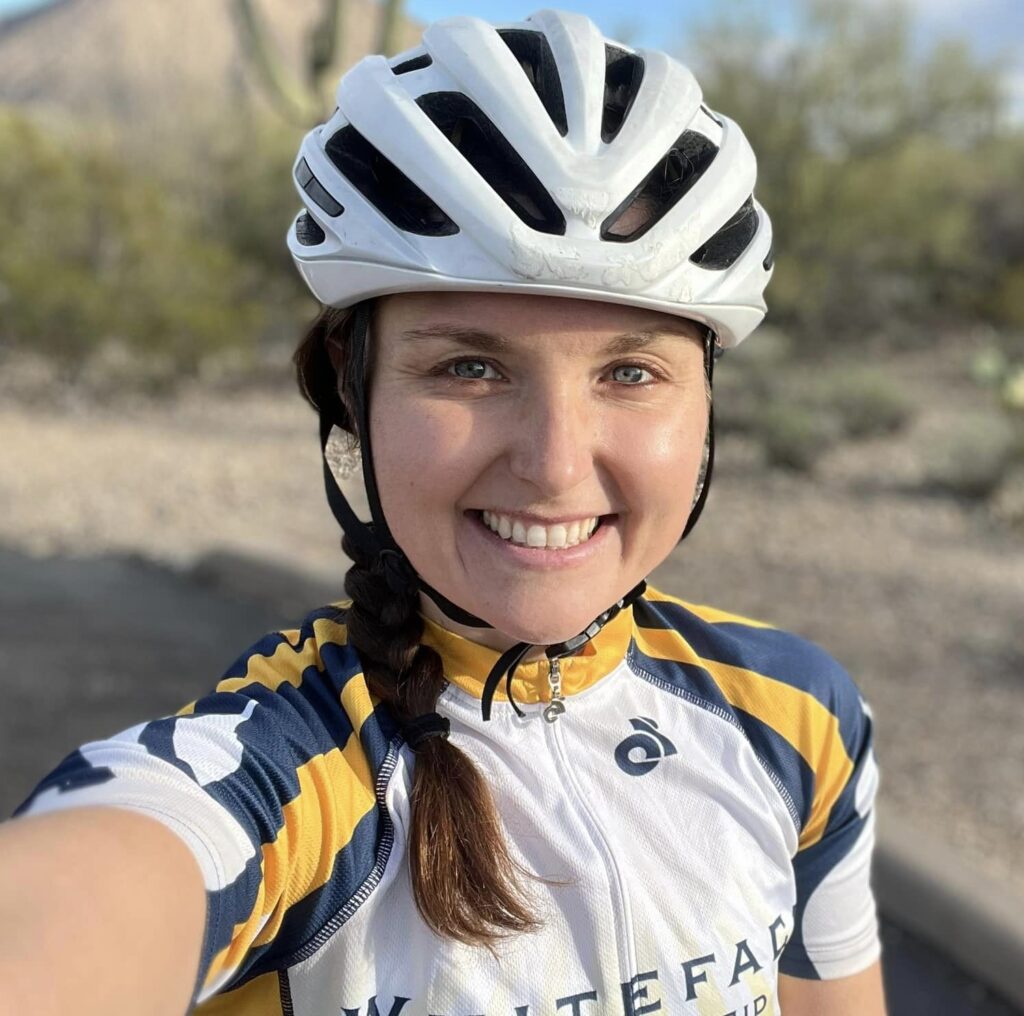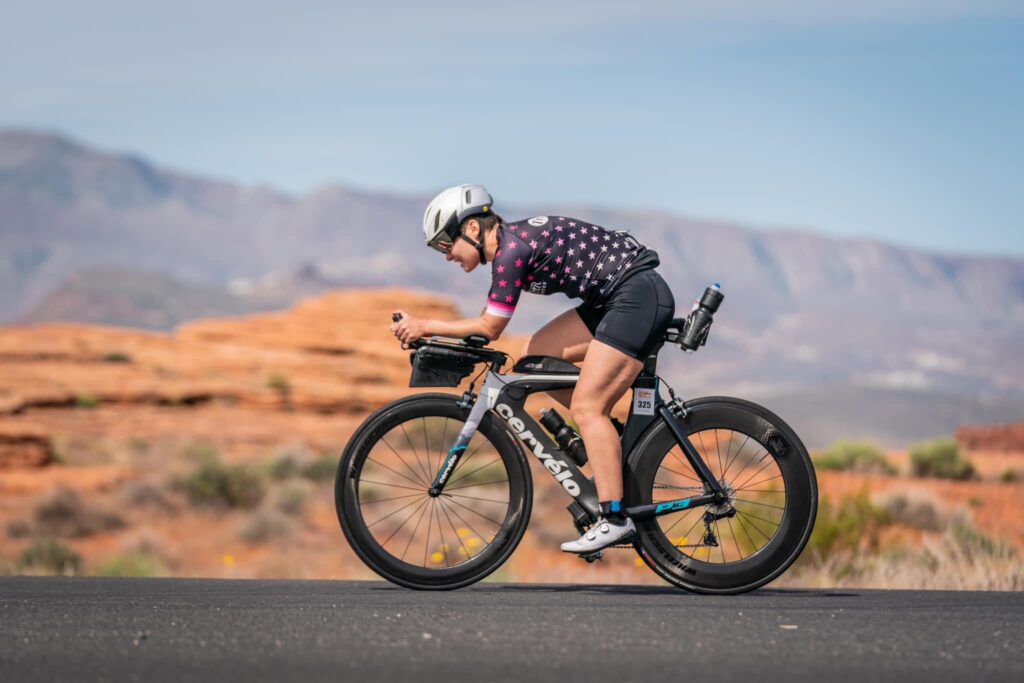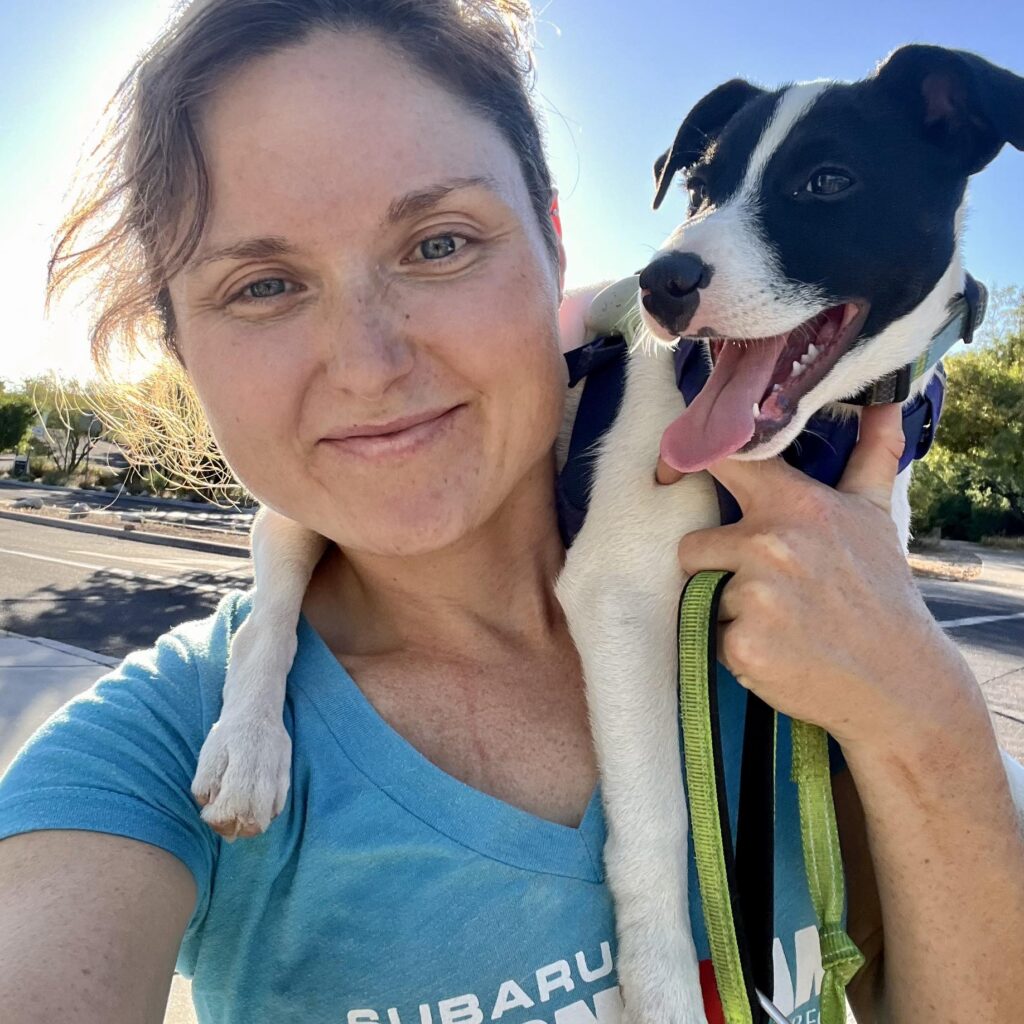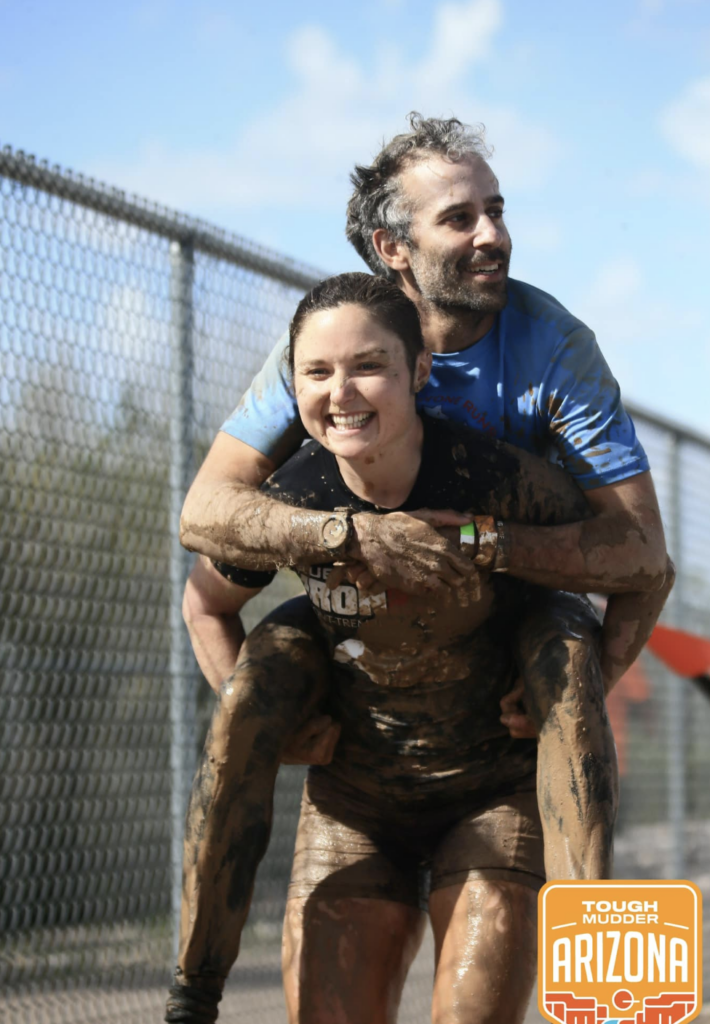
Sign up for a new account.
And get access to
The latest T1D content
Research that matters
Our daily questions
Sign up by entering your info below.
Reset Your Password
Don't worry.
We will email you instructions to reset your
password.
Editor’s Note: This article is based on Lauren Dahlin’s personal experience managing T1D while training and competing in triathlon events. Please consult your healthcare team before changing your diabetes care regimen.
 “I have to show everyone and show myself that this doesn’t change anything,” said Lauren Dahlin about her diagnosis with type 1 diabetes (T1D) at 26 years old in 2017. Today, she’s a true athlete who has competed in nine Ironman races — consisting of a 2.4-mile swim, a 112-mile bike ride, and a 26.2-mile run. Completed within about 14 hours!
“I have to show everyone and show myself that this doesn’t change anything,” said Lauren Dahlin about her diagnosis with type 1 diabetes (T1D) at 26 years old in 2017. Today, she’s a true athlete who has competed in nine Ironman races — consisting of a 2.4-mile swim, a 112-mile bike ride, and a 26.2-mile run. Completed within about 14 hours!
This past summer, Dahlin competed in the annual Ironman in Lake Placid, NY. The event came with a lot of pressure because placing within the top 24 racers meant qualifying for the biggest Ironman event of all: the World Championship in Kona, HI.
She did it. Dahlin placed 9th amongst about 600 other female competitors — becoming one of the first women with T1D to qualify for the Ironman in Kona, HI.
Here’s a closer look at Dahlin’s journey from diagnosis to rockstar competitive athlete.
Diagnosed just days before a potential DKA coma
“I couldn’t even walk half a flight of stairs without getting extremely winded because I was so far gone,” explains Dahlin of her pre-diagnosis symptoms. “The clinic gave me an inhaler for asthma and sent me home!”
Dahlin saw six different providers before someone finally gave her the appropriate diagnosis. They even performed a full-blood panel workup and didn’t diagnose her T1D. Eventually, Dahlin went to the emergency room in Boston, where she lived, and the staff told her she was experiencing diabetic ketoacidosis (DKA). She then spent ten days in the intensive care unit learning about her new life living with T1D.
“I was bummed that the doctors hadn’t caught my diagnosis earlier because there were a lot of clinical trials happening in Boston that I could have been a part of.”
Regardless, Dahlin didn’t want to slow down — within one month of her diagnosis, she signed up for her first half-marathon.
Year One with T1D
 Dahlin was always busy before her T1D diagnosis — and had started going to CrossFit — but she wouldn’t have described herself as an athlete. Her diagnosis motivated her to make exercise a major part of her life.
Dahlin was always busy before her T1D diagnosis — and had started going to CrossFit — but she wouldn’t have described herself as an athlete. Her diagnosis motivated her to make exercise a major part of her life.
She knew she needed more knowledge. She joined T1D athlete groups on social media, sought advice on training for marathons, and read as much as possible.
“I asked my medical team for guidance, too,” recalls Dahlin, “but they basically said, ‘yeah, we don’t know how to help you accomplish this.’” Within six months of her diagnosis, Dahlin felt ready to take on her first marathon, a JDRF-sponsored event at Walt Disney World. After running her first marathon, she was hooked and signed up for a half-Ironman competition. She completed her first full Ironman in 14 hours.
“After my first Ironman, I started working with my coach, Cliff Scherb, a fellow T1D,” explains Dahlin, who knew she needed to learn more to be more competitive. “I remember I said to him, ‘I’m doing this because I want to feel healthy,’ and he said to me, ‘if you want to be healthy, you should do Olympic short-distance triathlon.”
His point: full Ironman events are intensely stressful for the body. Even though she appreciated his advice, her mind was already set on achieving as much as possible in full Ironman events.
Dahlin learned everything she could from Scherb, CEO and Founder of Glucose Advisors — an online series of courses you can purchase to learn how to manage T1D during exercise, along with 1:1 coaching and general diabetes education.
The exercise-focused portion of their programming is appropriate for every level of T1D and exercise, but Dahlin warns that it digs deeply into the science. Many people, she suggests, might get very overwhelmed with that level of exercise science. But if you’re looking to learn a lot, Glucose Advisors is an incredible resource.
Within one year after her diagnosis, Dahlin signed up for her first full Ironman competition.
Managing T1D while training & competing in an Ironman
Competing in an Ironman without T1D is extremely challenging, but adding diabetes is extremely difficult.
“Fueling for training and the Ironman event itself is the hardest part, even without T1D,” explains Dahlin. “My first goal was to understand how non-diabetics are fueling their training and gradually make my way to doing the same.”
 The fuel required to thrive and survive the day is overwhelming during the event. Learning how to do this required immense patience.
The fuel required to thrive and survive the day is overwhelming during the event. Learning how to do this required immense patience.
“My coach said, ‘You’re gonna try to take in at least 60 grams of sugar per hour during the entire Ironman race’,” remembers Dahlin. “And I’m wondering how I will eat that many carbohydrates and manage insulin for nearly 17 hours? So, I just gradually started increasing my carb-consumption during training until I got to that point.”
During an Ironman, Dahlin said she strives to keep her blood glucose levels between 140 and 160 mg/dL. While her A1c has always been in the 5s, this higher range is critical during Ironman events.
“That’s where I feel most comfortable that nothing bad is going to happen that could affect my performance,” shared Dahlin. “On a performance level, I’m much more concerned about having lows during a race than being a little high.”
The science of T1D and competing in an Ironman is about learning exactly how much to increase/decrease insulin based on your activity — and the hours of activity still ahead.
“Studies on Ironman athletes without diabetes found that athletes are performing best when their blood sugars are actually in the 180 to 200 mg/dL range by consuming around 100 grams of carbohydrates per hour,” explains Dahlin. “This is a great example of the fact that performance is not the same as health.”
“One time, I got a little high during the bike ride part of a race, and I was too aggressive with my correction bolus,” recalls Dahlin. “I ended up having to walk for a good chunk of the marathon because of that. It sucked.”
Tips: Training for Ironman with T1D
So much goes into competing in training and competing in an Ironman event! A few tips from Dahlin include:
- Find a local triathlon group, meet them, join their runs, and get their support.
- Have a supporter(s) who will come to the races and cheer you on the entire way.
- Learn how to adapt to changes in insulin sensitivity throughout the season and the week because of changes in training intensity.
- Don’t be afraid to constantly evaluate your settings, as no two races will be the same.
- See what people who don’t have diabetes are doing, especially for fuel, and see how you can gradually make your way towards that point as someone with T1D.
- Remember that if you’re on a closed-loop pump, it learns off 3-day periods (Omnipod and Medtronic). This means it’s learning and assuming that all seven days of the week have similar activity levels. This won’t be true in Ironman training, so you’ll need to intervene and make adjustments.
- Budget and make it a financial priority: This sport is expensive. Dahlin keeps her housing costs low and has gotten many of her competition stuff (shoes, apparel, swim gear, a bike, bike gear, and running gear) used. She also leaned on her T1D athlete community to get what she needed for lower prices. She also prioritizes her budget to cover her meal expenses — needing around 3,000 calories daily. (Most people need no more than 2,000 calories daily).
- Dahlin also points out that she and her partner don’t have children — which provides more flexibility in their budget and ability to train and travel. This intense traveling lifestyle is a joint decision they’ve committed to together. But they do bring their puppy, Miles, everywhere!
Nine Ironman Competitions Later
After six years of living with T1D, getting active in the triathlon community, and competing worldwide in Ironman events, Dahlin is among the first women living with T1D to qualify for Kona, HI.
 “I’m hopeful that as Ironman tries to bring more women into the sport, more women with chronic illnesses or disabilities realize that this is open to them, too.” Keep an eye out for Dahlin and her partner, Peter Vieira, at the Ironman in Kona.
“I’m hopeful that as Ironman tries to bring more women into the sport, more women with chronic illnesses or disabilities realize that this is open to them, too.” Keep an eye out for Dahlin and her partner, Peter Vieira, at the Ironman in Kona.
Dahlin and Vieira met randomly in a dating app, not realizing she and his T1D sister were already connected acquaintances in the T1D community.
“Actually, I wasn’t even gonna say yes to a date until he spotted my Dexcom in a photo and said his sister had T1D,” laughs Dahlin. “I realized I was already friends with his sister on Facebook, so I said yes to the date.”
Since then, Vieira has become her biggest supporter and on-hand crew at races.
“Having a supporter makes the whole thing much easier,” says Dahlin. “There are so many logistics and equipment – just having someone there to help you drop off all your stuff means everything. And to come to the finish line, greeted by someone you love, it’s a wonderful feeling. When I’ve done it alone, without Pete, I remember feeling really lonely when I crossed the finish line and didn’t have a support system there.”
Pushing herself during Lake Placid to qualify for Kona meant relying a bit more than usual on Vieira after completing the race.
“I went as hard as possible during the marathon part in Lake Placid,” explains Dahlin, “and I could not walk after I crossed the finish line. I had to sit down. I exerted myself so much during the run that I could not even walk back to the hotel. Pete had to get the car and convince them to let him drive right up to me near the finish line.”
Vieira, meanwhile, is glad to support Dahlin from the sidelines — with no plans to participate.
“At her race in Cozumel, Mexico,” explains Vieira. “I remember it was really hot, and everyone is still running after hours and hours, and they’re just dying in the heat. And it’s so late, we’ve been out here since the crack of dawn, and I’m just thinking, ‘Why are we still out here?’” laughs Vieira. “I love supporting Lauren, but the experience of supporting her has convinced me never to do an Ironman.”
Dahlin appreciates both sentiments.
“The best supporters,” laughs Dahlin, “are the people who think you’re crazy, but they’re cool with you doing it anyway.”
Catch Dahlin crushing the 140.6-mile journey this October!







